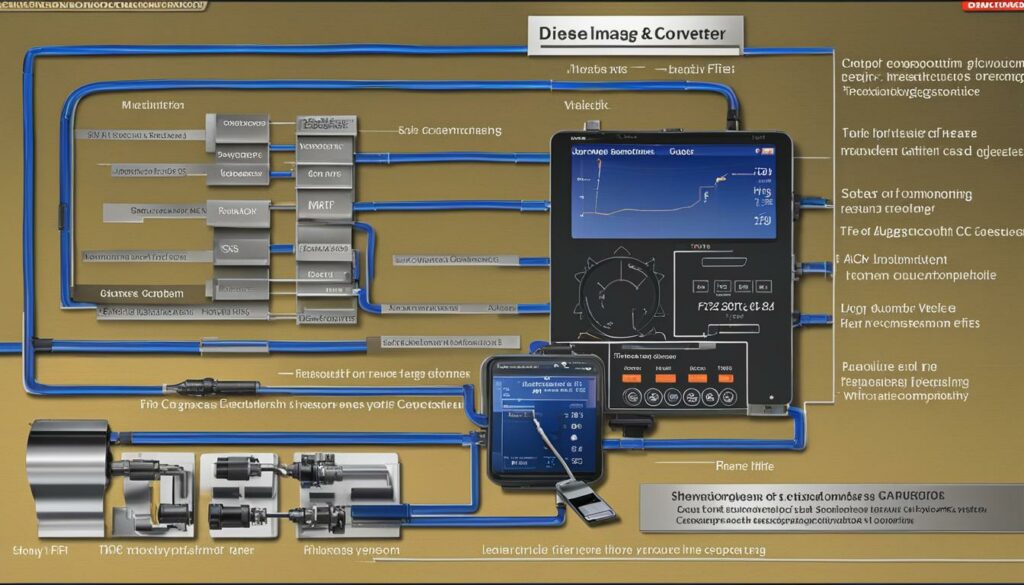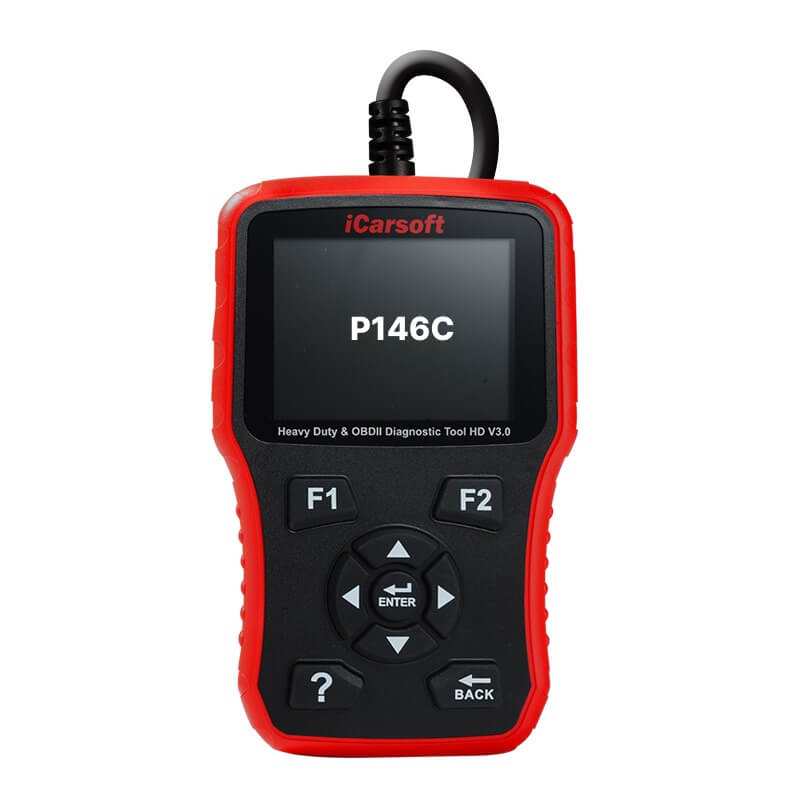P146C – Diesel Oxidation Catalyst Not Ready For Diagnostics
POSTED IN pcodes
Welcome to our article on the P146C diagnostic trouble code. In this section, we will discuss the issue of the diesel oxidation catalyst (DOC) not being ready for diagnostics in your vehicle’s emission control system. This code indicates that there may be a problem with the catalyst monitoring system, leading to potential concerns with vehicle emissions and engine efficiency.
The diesel oxidation catalyst (DOC) is a crucial part of the emission control system in your vehicle. Its primary function is to reduce harmful emissions from the engine. However, when the DOC is not ready for diagnostics, it means that the engine diagnostics are unable to effectively monitor its performance. This can result in increased vehicle emissions and reduced engine efficiency, affecting both the environment and the overall performance of your vehicle.
It is essential to address this issue promptly to ensure optimal vehicle performance and compliance with emission regulations. In the following sections, we will delve deeper into understanding the P146C diagnostic trouble code, its symptoms, common causes, troubleshooting steps, and the necessary repairs and solutions to resolve this issue.
Key Takeaways
- The P146C diagnostic trouble code indicates that the diesel oxidation catalyst (DOC) is not ready for diagnostics in your vehicle’s emission control system.
- If the DOC is not ready for diagnostics, it can lead to increased vehicle emissions and reduced engine efficiency.
- Addressing the P146C code is crucial for optimal vehicle performance and compliance with emission regulations.
- Factors that can contribute to the P146C code include malfunctioning catalyst monitoring system components, damaged or contaminated catalyst, or wiring and connection issues.
- Diagnosing the cause of the code may require professional assistance and using diagnostic equipment.
Understanding the P146C Diagnostic Trouble Code
The P146C diagnostic trouble code specifically refers to the diesel oxidation catalyst (DOC) not being ready for diagnostics. This code is stored in the vehicle’s onboard diagnostics system when the engine control unit (ECU) detects that the DOC is not functioning properly and cannot be monitored effectively.
Various factors can contribute to the DOC not being ready for diagnostics, including a malfunctioning catalyst or issues with the catalyst monitoring system. It is crucial to diagnose and address this issue promptly to ensure the proper functioning of the emission control system and reduce vehicle emissions.
Buy tested tuning file for Adblue / EGR / DPF / Adblue off now!
- What is the P146C diagnostic trouble code?
- Why is it important to address this code?
- What can cause the DOC to not be ready for diagnostics?
Let’s dive deeper into these questions to gain a better understanding of the P146C diagnostic trouble code.
What is the P146C Diagnostic Trouble Code?
The P146C diagnostic trouble code is a specific code that indicates the diesel oxidation catalyst (DOC) is not ready for diagnostics. When this code is triggered, it means that the engine control unit (ECU) has detected an issue with the DOC’s functionality, preventing effective monitoring of the catalyst’s performance.
Importance of Addressing the P146C Code
Addressing the P146C diagnostic trouble code is crucial for several reasons:
- Reduced Vehicle Emissions: Proper functioning of the DOC is essential for minimizing harmful emissions from the vehicle. When the catalyst is not ready for diagnostics, it may lead to increased vehicle emissions, posing a threat to the environment and human health.
- Emission Control System Performance: The DOC plays a vital role in the vehicle’s emission control system. When it is not functioning properly, the overall performance of the emission control system may be compromised. This can affect the vehicle’s compliance with emission regulations and result in decreased engine efficiency.
- Prevent Further Damage: Ignoring the P146C code can potentially lead to additional damage to the emission control system. It is important to diagnose and repair the underlying issues promptly to prevent further complications and costly repairs.
Causes of the DOC Not Being Ready for Diagnostics
There are several potential causes for the DOC not being ready for diagnostics:
| Cause | Description |
|---|---|
| Malfunctioning Catalyst | A damaged or contaminated catalyst can prevent it from functioning properly, leading to the not ready for diagnostics condition. |
| Catalyst Monitoring System Issues | Issues with the catalyst monitoring system components, such as sensors or wiring, can contribute to the not ready for diagnostics condition. |
| Wiring and Connection Problems | Faulty wiring or poor connections between the catalyst and the monitoring system can impact the catalyst’s readiness for diagnostics. |
Identifying the specific cause requires a thorough inspection and diagnostic testing of the vehicle’s emission control system.
Now that we understand the P146C diagnostic trouble code and its significance, let’s explore the symptoms and severity of this code in the next section.

Symptoms and Severity of the P146C Diagnostic Trouble Code
The P146C diagnostic trouble code can manifest in various symptoms, which may differ depending on the vehicle and its emission control system. However, there are common indicators to watch out for when dealing with this code. These include the illumination of the check engine light and potential reductions in engine performance and fuel efficiency.
Common Symptoms:
- Illumination of the check engine light
- Reductions in engine performance
- Decreased fuel efficiency
These symptoms can be disruptive to the overall functioning of the vehicle and may negatively affect the driving experience. It is crucial to address the P146C diagnostic trouble code promptly to prevent further damage to the emission control system and ensure compliance with emission regulations.
The severity of the P146C code can range from mild to severe, depending on the underlying cause. The impact on vehicle performance and emissions can vary based on the specific system affected by the code. Prompt diagnosis and resolution of this code are essential to prevent potential worsening of symptoms and minimize the impact on the overall vehicle operation.
Let’s take a closer look at the symptoms and severity of the P146C diagnostic trouble code to understand its potential effects on your vehicle’s performance and emissions control system.
“The P146C diagnostic trouble code may have varying symptoms, but it often leads to decreased engine performance and fuel efficiency. It’s crucial to address this code promptly to prevent further damage to the emission control system and maintain compliance with regulations.” – Expert Mechanic
Common Causes and Troubleshooting Steps for the P146C Diagnostic Trouble Code
When the P146C diagnostic trouble code appears, it is essential to identify and address the underlying causes promptly. This code signifies that the diesel oxidation catalyst (DOC) is not ready for diagnostics, indicating potential issues with the emission control system. To troubleshoot this problem effectively, consider the following common causes and follow the recommended steps:
Common Causes:
- Damage or contamination of the diesel oxidation catalyst
- Malfunctioning catalyst monitoring system components
- Wiring and connection issues
Troubleshooting Steps:
- Perform a thorough inspection of the catalyst and related components for any visible damage or contamination.
- Check for leaks in the catalyst system and repair them if necessary.
- Test the functionality of sensors and wiring to ensure proper connection and communication.
- Utilize diagnostic tools to retrieve and analyze data from the vehicle’s onboard diagnostics system.
By following these troubleshooting steps, you can effectively identify and resolve the issues causing the P146C diagnostic trouble code. It is crucial to address these problems promptly to ensure optimal performance of the emission control system and compliance with emission regulations.
| Common Causes | Troubleshooting Steps |
|---|---|
| Damage or contamination of the diesel oxidation catalyst | Perform a thorough inspection of the catalyst and related components for any visible damage or contamination. |
| Malfunctioning catalyst monitoring system components | Check for leaks in the catalyst system and repair them if necessary. |
| Wiring and connection issues | Test the functionality of sensors and wiring to ensure proper connection and communication. |
| Utilize diagnostic tools to retrieve and analyze data from the vehicle’s onboard diagnostics system. |

Following these troubleshooting steps should help you identify and resolve the issues related to the P146C diagnostic trouble code. If you encounter difficulties or are unsure how to proceed, it is recommended to seek professional assistance from a certified technician or automotive service center.
Repair and Resolution for the P146C Diagnostic Trouble Code
Once the cause of the P146C diagnostic trouble code has been identified, the necessary repairs can be made to resolve the issue. Depending on the specific situation, the repair process may involve the following steps:
- Inspect and Replace the Diesel Oxidation Catalyst: If the diagnostic tests reveal that the diesel oxidation catalyst (DOC) is damaged or has exceeded its lifespan, it will need to be replaced. Obtaining a genuine DOC from a reputable manufacturer is crucial for optimal performance and compatibility.
- Repair or Replace Malfunctioning Components: In some cases, the issues causing the P146C code may be related to malfunctioning components of the catalyst monitoring system. These components, such as sensors or wiring, may need to be repaired or replaced to ensure proper functioning.
- Address Wiring and Connection Issues: Faulty wiring or connections can also contribute to the P146C diagnostic trouble code. Thoroughly inspecting the wiring and connectors associated with the DOC and the catalyst monitoring system is essential. Any issues should be addressed promptly, such as repairing damaged wires or securing loose connections.
Throughout the repair process, it is crucial to follow the manufacturer’s recommended procedures and guidelines. This ensures that the repairs are performed correctly and in compliance with the vehicle’s specifications. Using genuine parts or approved replacements is essential to maintain the integrity of the emission control system.
After the necessary repairs have been completed, it is important to clear the P146C diagnostic trouble code from the vehicle’s onboard diagnostics system. This can typically be done using specialized diagnostic equipment. Additionally, performing comprehensive testing and monitoring is essential to ensure that the code does not reoccur and that the emission control system is functioning optimally.
When addressing the P146C diagnostic trouble code, professional assistance may be required to properly diagnose and repair the underlying issues. Working with an experienced technician or mechanic can help ensure that the repairs are performed accurately and efficiently.
Conclusion
The P146C diagnostic trouble code indicates that the diesel oxidation catalyst (DOC) is not ready for diagnostics. When this code is present, it can result in increased vehicle emissions and reduced engine efficiency. To ensure optimal performance of the emission control system and compliance with emission regulations, it is crucial to diagnose and repair the underlying issues causing this code.
Professional assistance may be necessary to properly diagnose and address the P146C code. A thorough inspection of the catalyst and related components, as well as tests using diagnostic equipment, may be required. Alternatively, there is an alternative solution available, which involves permanently removing the code by uploading the Engine Control Unit (ECU) file to a specialized portal.
By taking appropriate actions, such as repairing or replacing a damaged catalyst, addressing malfunctioning components of the catalyst monitoring system, or resolving wiring and connection issues, the vehicle’s performance can be improved and its impact on the environment minimized. Ensuring efficient functioning of the emission control system is crucial in reducing vehicle emissions and promoting a cleaner, greener future.
FAQ
What does the P146C diagnostic trouble code mean?
The P146C diagnostic trouble code indicates that the diesel oxidation catalyst (DOC) is not ready for diagnostics. This means that the engine diagnostics are unable to properly monitor the performance of the catalyst.
What is the diesel oxidation catalyst (DOC)?
The diesel oxidation catalyst (DOC) is a part of the emission control system in a vehicle. It is responsible for reducing harmful emissions and plays a crucial role in maintaining engine efficiency.
What are the symptoms of the P146C diagnostic trouble code?
The symptoms can include the illumination of the check engine light as well as potential reductions in engine performance and fuel efficiency.
How severe is the P146C diagnostic trouble code?
The severity of the code can range from mild to severe, depending on the underlying cause. It is important to address this code promptly to prevent any further damage and ensure compliance with emission regulations.
What are the common causes of the P146C diagnostic trouble code?
The common causes can include issues with the diesel oxidation catalyst itself, malfunctioning catalyst monitoring system components, or wiring and connection issues.
What are the troubleshooting steps for the P146C diagnostic trouble code?
Troubleshooting steps may include visual inspections, checking for any damage or leaks, testing the functionality of sensors and wiring, and using diagnostic tools to retrieve and analyze data from the vehicle’s onboard diagnostics system.
How can the P146C diagnostic trouble code be repaired?
The necessary repairs may involve replacing a damaged diesel oxidation catalyst, repairing or replacing malfunctioning components of the catalyst monitoring system, or addressing any wiring or connection issues. It is important to follow the manufacturer’s recommended repair procedures and use genuine parts or approved replacements.
Can I permanently remove the P146C diagnostic trouble code?
Yes, it is possible to permanently remove the code by uploading the Engine Control Unit (ECU) file to a specialized portal. However, it is recommended to diagnose and address the underlying issues causing the code to ensure optimal performance of the emission control system and compliance with emission regulations.


